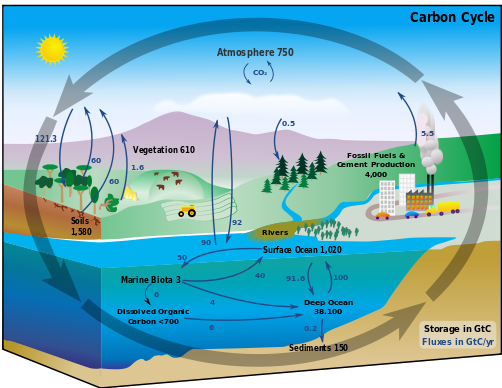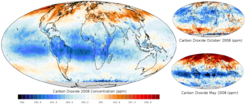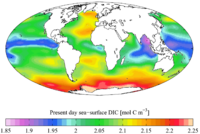Carbon cycle

The carbon cycle is the biogeochemical cycle by which carbon is exchanged among the biosphere, pedosphere, geosphere, hydrosphere, and atmosphere of the Earth. It is one of the most important cycles of the earth and allows for carbon to be recycled and reused throughout the biosphere and all of its organisms.
The carbon cycle was initially discovered by Joseph Priestley and Antoine Lavoisier, and popularized by Humphry Davy.[1] It is now usually thought of as five major reservoirs of carbon interconnected by pathways of exchange. These reservoirs are:
- The atmosphere
- The terrestrial biosphere, which is usually defined to include fresh water systems and non-living organic material, such as soil carbon.
- The oceans, including dissolved inorganic carbon and living and non-living marine biota,
- The sediments including fossil fuels.
- The Earth's interior, carbon from the Earth's mantle and crust is released to the atmosphere and hydrosphere by volcanoes and geothermal systems.
The annual movements of carbon, the carbon exchanges between reservoirs, occur because of various chemical, physical, geological, and biological processes. The ocean contains the largest active pool of carbon near the surface of the Earth, but the deep ocean part of this pool does not rapidly exchange with the atmosphere in the absence of an external influence, such as a black smoker or an uncontrolled deep-water oil well leak.
The global carbon budget is the balance of the exchanges (incomes and losses) of carbon between the carbon reservoirs or between one specific loop (e.g., atmosphere ↔ biosphere) of the carbon cycle. An examination of the carbon budget of a pool or reservoir can provide information about whether the pool or reservoir is functioning as a source or sink for carbon dioxide.
Contents |
In the atmosphere

Carbon exists in the Earth's atmosphere primarily as the gas carbon dioxide (CO2). Although it is a small percentage of the atmosphere (approximately 0.04% on a molar basis), it plays a vital role in supporting life. Other gases containing carbon in the atmosphere are methane and chlorofluorocarbons (the latter is entirely anthropogenic). Trees convert carbon dioxide into carbohydrates during photosynthesis, releasing oxygen in the process. This process is most prolific in relatively new forests where tree growth is still rapid. The effect is strongest in deciduous forests during spring leafing out. This is visible as an annual signal in the Keeling curve of measured CO2 concentration. Northern hemisphere spring predominates, as there is far more land in temperate latitudes in that hemisphere than in the southern.
- Forests store 86% of the planet's above-ground carbon and 73% of the planet's soil carbon.[2]
- At the surface of the oceans towards the poles, seawater becomes cooler and more carbonic acid is formed as CO2 becomes more soluble. This is coupled to the ocean's thermohaline circulation which transports dense surface water into the ocean's interior (see the entry on the solubility pump).
- In upper ocean areas of high biological productivity, organisms convert reduced carbon to tissues, or carbonates to hard body parts such as shells and tests. These are, respectively, oxidized (soft-tissue pump) and redissolved (carbonate pump) at lower average levels of the ocean than those at which they formed, resulting in a downward flow of carbon (see entry on the biological pump).
- The weathering of silicate rock (see Carbonate-Silicate Cycle). Carbonic acid reacts with weathered rock to produce bicarbonate ions. The bicarbonate ions produced are carried to the ocean, where they are used to make marine carbonates. Unlike dissolved CO2 in equilibrium or tissues which decay, weathering does not move the carbon into a reservoir from which it can readily return to the atmosphere.
- In 1958, atmospheric carbon dioxide at Mauna Loa was about 320 parts per million (ppm), and in 2010 it is about 385ppm[3].
- Future CO2 emission can be calculated by the kaya identity
Carbon is released into the atmosphere in several ways:
- Through the respiration performed by plants and animals. This is an exothermic reaction and it involves the breaking down of glucose (or other organic molecules) into carbon dioxide and water.
- Through the decay of animal and plant matter. Fungi and bacteria break down the carbon compounds in dead animals and plants and convert the carbon to carbon dioxide if oxygen is present, or methane if not.
- Through combustion of organic material which oxidizes the carbon it contains, producing carbon dioxide (and other things, like water vapor). Burning fossil fuels such as coal, petroleum products, and natural gas releases carbon that has been stored in the geosphere for millions of years. Burning agrofuels also releases carbon dioxide which has been stored for only a few years or less.
- Production of cement. Carbon dioxide is released when limestone (calcium carbonate) is heated to produce lime (calcium oxide), a component of cement.
- At the surface of the oceans where the water becomes warmer, dissolved carbon dioxide is released back into the atmosphere.
- Volcanic eruptions and metamorphism release gases into the atmosphere. Volcanic gases are primarily water vapor, carbon dioxide and sulfur dioxide. The carbon dioxide released is roughly equal to the amount removed by silicate weathering [citation needed]; so the two processes, which are the chemical reverse of each other, sum to roughly zero, and do not affect the level of atmospheric carbon dioxide on time scales of less than about 100,000 years.
In the biosphere
Biosphere carbon is also known as green carbon. Around 42,000 gigatonnes of carbon are present in the biosphere. Carbon is an essential part of life on Earth. It plays an important role in the structure, biochemistry, and nutrition of all living cells. Biosphere carbon is divided into three carbon pools: living biomass, dead biomass and soil.
- Autotrophs are organisms that produce their own organic compounds using carbon dioxide from the air or water in which they live. To do this they require an external source of energy. Almost all autotrophs use solar radiation to provide this, and their production process is called photosynthesis. A small number of autotrophs exploit chemical energy sources in a process called chemosynthesis. The most important autotrophs for the carbon cycle are trees in forests on land and phytoplankton in the Earth's oceans. Photosynthesis follows the reaction 6CO2 + 6H2O → C6H12O6 + 6O2
- Carbon is transferred within the biosphere as heterotrophs feed on other organisms or their parts (e.g., fruits). This includes the uptake of dead organic material (detritus) by fungi and bacteria for fermentation or decay.
- Most carbon leaves the biosphere through respiration. When oxygen is present, aerobic respiration occurs, which releases carbon dioxide into the surrounding air or water, following the reaction C6H12O6 + 6O2 → 6CO2 + 6H2O. Otherwise, anaerobic respiration occurs and releases methane into the surrounding environment, which eventually makes its way into the atmosphere or hydrosphere (e.g., as marsh gas or flatulence).
- Burning of biomass (e.g. forest fires, wood used for heating, anything else organic) can also transfer substantial amounts of carbon to the atmosphere
- Carbon may also be circulated within the biosphere when dead organic matter (such as peat) becomes incorporated in the geosphere. Animal shells of calcium carbonate, in particular, may eventually become limestone through the process of sedimentation.
- Much remains to be learned about the cycling of carbon in the deep ocean. For example, a recent discovery is that larvacean mucus houses (commonly known as "sinkers") are created in such large numbers that they can deliver as much carbon to the deep ocean as has been previously detected by sediment traps.[4] Because of their size and composition, these houses are rarely collected in such traps, so most biogeochemical analyses have erroneously ignored them.
Carbon storage in the biosphere is influenced by a number of processes on different time-scales: while net primary productivity follows a diurnal and seasonal cycle, carbon can be stored up to several hundreds of years in trees and up to thousands of years in soils. Changes in those long term carbon pools (e.g. through de- or afforestation or through temperature-related changes in soil respiration) may thus affect global climate change.
In the ocean

The oceans contain around 36,000 gigatonnes of carbon, mostly in the form of bicarbonate ion (over 90%, with most of the remainder being carbonate). Extreme storms such as hurricanes and typhoons bury a lot of carbon, because they wash away so much sediment. For instance, a team reported in the July 2008 issue of the journal Geology that a single typhoon in Taiwan buries as much carbon in the ocean—in the form of sediment—as all the other rains in that country all year long combined.[5] Inorganic carbon, that is carbon compounds with no carbon-carbon or carbon-hydrogen bonds, is important in its reactions within water. This carbon exchange becomes important in controlling pH in the ocean and can also vary as a source or sink for carbon. Carbon is readily exchanged between the atmosphere and ocean. In regions of oceanic upwelling, carbon is released to the atmosphere. Conversely, regions of downwelling transfer carbon (CO2) from the atmosphere to the ocean. When CO2 enters the ocean, it participates in a series of reactions which are locally in equilibrium:
Solution:
-
- CO2(atmospheric) ⇌ CO2(dissolved)
Conversion to carbonic acid:
-
- CO2(dissolved) + H2O ⇌ H2CO3
First ionization:
-
- H2CO3 ⇌ H+ + HCO3− (bicarbonate ion)
Second ionization:
-
- HCO3− ⇌ H+ + CO3−− (carbonate ion)
This set of reactions, each of which has its own equilibrium coefficient, determines the form that inorganic carbon takes in the oceans[6]. The coefficients, which have been determined empirically for ocean water, are themselves functions of temperature, pressure, and the presence of other ions (especially borate). In the ocean the equilibria strongly favor bicarbonate. Since this ion is three steps removed from atmospheric CO2, the level of inorganic carbon storage in the ocean does not have a proportion of unity to the atmospheric partial pressure of CO2. The factor for the ocean is about ten: that is, for a 10% increase in atmospheric CO2, oceanic storage (in equilibrium) increases by about 1%, with the exact factor dependent on local conditions. This buffer factor is often called the "Revelle Factor", after Roger Revelle.
In the oceans, dissolved carbonate can combine with dissolved calcium to precipitate solid calcium carbonate, CaCO3, mostly as the shells of microscopic organisms. When these organisms die, their shells sink and accumulate on the ocean floor. Over time these carbonate sediments form limestone which is the largest reservoir of carbon in the carbon cycle. The dissolved calcium in the oceans comes from the chemical weathering of calcium-silicate rocks, during which carbonic and other acids in groundwater react with calcium-bearing minerals liberating calcium ions to solution and leaving behind a residue of newly formed aluminium-rich clay minerals and insoluble minerals such as quartz.
See also
- C4MIP
- Carbon cycle re-balancing
- Carbon footprint
- Global Carbon Project
- Carbon diet
- Low carbon diet
- Ocean acidification
- Primary production
- Breathing
- Calvin cycle
- biochar
- Integrated Carbon Observation System
References
- ↑ Holmes, Richard. "The Age Of Wonder", Pantheon Books, 2008. ISBN 978-0-375-42222-5.
- ↑ Sedjo, Roger.1993. The Carbon Cycle and Global Forest Ecosystem. Water, Air, and Soil Pollution 70, 295-307. (via Oregon Wild Report on Forests, Carbon, and Global Warming)
- ↑ Trends in Carbon Dioxide — NOAA Earth System Research Laboratory
- ↑ Monterey Bay Aquarium Research Institute (MBARI) (2005-06-09). ""Sinkers" provide missing piece in deep-sea puzzle". Press release. http://www.mbari.org/news/news_releases/2005/sinkers-release.pdf. Retrieved 2007-10-07.
- ↑ Typhoons Bury Tons of Carbon in the Oceans Newswise, Retrieved on July 27, 2008.
- ↑ Millero, Frank J. (2005). Chemical Oceanography (3 ed.). CRC Press. ISBN 0849322804.
Further reading
- Appenzeller, Tim (2004). "The case of the missing carbon". National Geographic Magazine. http://environment.nationalgeographic.com/environment/global-warming/missing-carbon.html. - article about the missing carbon sink
- Bolin, Bert; Degens, E. T.; Kempe, S.; Ketner, P. (1979). The global carbon cycle. Chichester ; New York: Published on behalf of the Scientific Committee on Problems of the Environment (SCOPE) of the International Council of Scientific Unions (ICSU) by Wiley. ISBN 0471997102. http://www.icsu-scope.org/downloadpubs/scope13/index.html. Retrieved 2008-07-08.
- Houghton, R. A. (2005). "The contemporary carbon cycle". In William H Schlesinger (editor). Biogeochemistry. Amsterdam: Elsevier Science. pp. 473–513. ISBN 0080446426.
- Janzen, H. H. (2004). "Carbon cycling in earth systems—a soil science perspective". Agriculture, ecosystems and environment 104 (3): 399–417. doi:10.1016/j.agee.2004.01.040.
- Millero, Frank J. (2005). Chemical Oceanography (3 ed.). CRC Press. ISBN 0849322804.
- Sundquist, Eric; Broecker, Wallace S.(editors) (1985). The Carbon Cycle and Atmospheric CO2: Natural variations Archean to Present. Geophysical Monographs Series. American Geophysical Union.
External links
- Carbon Cycle Science Program - an interagency partnership.
- NOAA's Carbon Cycle Greenhouse Gases Group
- Global Carbon Project - initiative of the Earth System Science Partnership
- UNEP - The present carbon cycle - Climate Change carbon levels and flows
- NASA's Orbiting Carbon Observatory
- Carboscope, a website presenting maps of fluxes of greenhouse gases (CO2 and CH4)
- CarboSchools, a European website with many resources to study carbon cycle in secondary schools.* * * *
- Carbon and Climate, an educational website with a carbon cycle applet for modeling your own projection.
|
|||||
|
|||||||||||||||||||||||||||||||||||||||||||||||||||||||||||||||||||||||||||||||||||||||||||||||||||||||